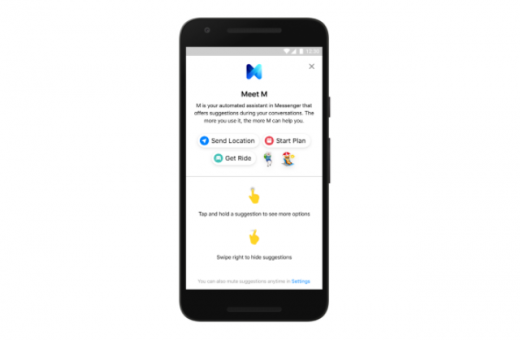F8: Facebook Wants to Read Your Mind – And More
— April 21, 2017
Mark Zuckerberg led the second biggest F8 event this past week – just behind a certain popular movie franchise known for its cars and cast that break the laws of physics.
Zuckerberg’s F8, or “Facebook Developer Conference,” takes place once a year in Silicon Valley, where Facebook announces major updates, showcases interactive demos, and talks about social media best practices.
This year’s new feature announcements came fast and furious, with talks of how Facebook’s family of apps will grow to connect humans across the world.
“For the past decade, Facebook has focused on friends and family,” Zuckerberg said. “Our next focus is building community… in the future, technology is going to make us more productive and free us up to enjoy interacting with each other.”
Facebook already brings in 2 billion active monthly users on the platform, but now it’s about introducing technology that will enhance these relationships.
Here’s everything you need to know about F8 2017.
1) Facebook Spaces: Why Facebook Bought Oculus Rift
On Tuesday, Zuckerberg announced Facebook Spaces, a new VR app now available on the Oculus Rift. Spaces explains why Zuckerberg bought the Oculus Rift for $ 2 billion – it positions Facebook as a major player in social VR.
When you open Spaces, it automatically logs into your Facebook account and populates all of the information you’ve saved on your profile, including profile photos and 360-degree content.
As of right now, the functionality is somewhat limited. You can use a selfie stick to take a VR photo of yourself and your friends. There’s also a marker you can use to sketch up interactive 3D objects, like a pair of glasses that you put on your friend’s face. But nothing revolutionary like discovering new worlds together.
The Facebook team has tested out more complex activities, but they found that the more users concentrate on an activity, the less they focus on one another. The core goal for Spaces is for users to deepen in relationship with friends and family.
Don’t own an Oculus Rift? Feeling a bit of FOMO? Don’t worry – Facebook Spaces is also integrated with Facebook Messenger. Users can video call from within VR to connect with other Messengers, whether you’re on a phone, desktop, or tablet.
2) M for Messenger… Your New Digital Mom?
We’ve seen Facebook Messenger headed in this direction for a long time now. In 2014, Facebook separated Messenger from its main app, building it into its own dedicated app. Over the next few years, we saw the addition of group voice call, location sharing, doodling, third-party integrations, chatbots, and more.
Now, Facebook has announced new capabilities for M, Facebook’s Virtual Reality Assistant.
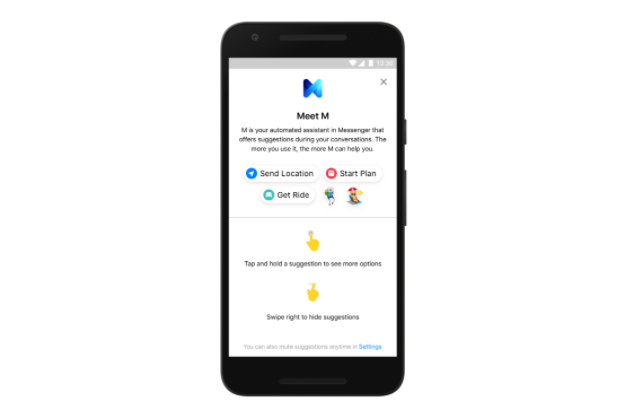
M will suggest features to use based on the conversations you’re having with friends. If someone says they’re hungry, M will suggest some nearby restaurants. If you write “you owe me $ 25, M will suggest a payment feature. And if your friends are talking about getting together somewhere, M might suggest ordering a Lyft.
Arielle Pardes of Wired, says that “The new M sounds like a digital version of your mom—reminding you when to eat dinner, helping you pay for things…”
This technology will also holds big implications for small businesses. The new rollout also includes Smart Replies, a bot-based feature that allows businesses to set auto-replies to commonly asked questions. This is a great resource for businesses who are low on staff and time but not able to invest in developing a chatbot.
3) Camera Effects: Fancier Snapchat Filters… Or Not?
There was also a series of new Augmented Reality (AR) features announced via Facebook’s newest Camera Effects platform. Users can now use face filters and other effects to turn a 2D photo into a 3D image. Facebook’s camera will now be equipped with technology that can read an object in an image and suggest effects.
You can add in a superhero mask before sharing an image. You can add in some suspense by dropping swimming sharks into your cup. Or if you’re hanging out alone, you can now use effects to add in some company – simply drop in an extra cup of coffee on your table.
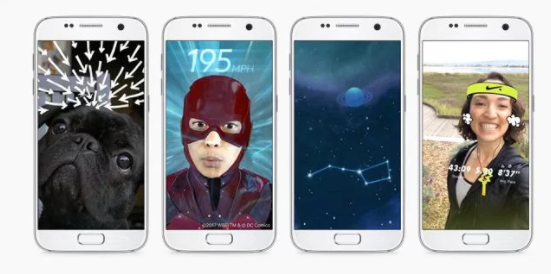
They sound suspiciously like fancier Snapchat Filters, right?
Not quite – there’s more.
Facebook is now allowing developers to apply for access to the closed beta of the platform’s AR Studio tool. This means developers will be able to play around with location, object recognition, and depth detection to create unique experiences in Camera Effects that aren’t possible in the real world.
Personally, what I find most fascinating is the usage of geolocation and AR. Users can now leave notes on their refrigerator as a personal reminder, or leave dish recommendations in certain restaurants for their friends to discover at a later time.
The fact that Facebook is baking AR into their camera tool is a really smart move. Facebook has more expertise and brand recognition as a software company rather than a hardware company. The development of a new piece of AR technology right now would be costly and adoption would be a challenge. Facebook Messenger, on the other hand, has already amassed one billion active monthly users.
“Luckily, the next phase of AR on camera phones won’t require special hardware… we don’t need to build the phones because the phones are already there,” says Zuckerberg.
4) Workplace: Moving Up The Ladder
Facebook is not slacking off with Workplace by Facebook. At just a little over a year old, Workplace is in use in every continent – including Antarctica. It’s also currently being used by 14,000 organizations in 77 languages.
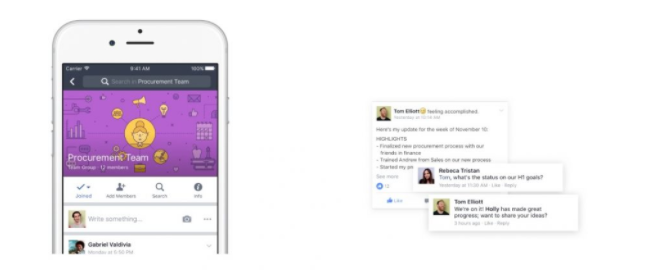
At F8, Facebook announced major updates coming to Workplace, including integrations with enterprise services like Microsoft and Salesforce, custom bots, and e-discovery and compliance partnerships.
These additions can make Workplace a serious contender in the corporate productivity services space. Not only will Workplace be fully compatible with the full Microsoft and Google suites, custom bots allow employees to automate workflows. A simple @mention can trigger a task.
Another enticing feature for corporate teams is Workplace’s security partnerships. Workplace will now feature webhooks that alert the company of any suspicious activity and data leakage.
Workplace hasn’t been making headlines as much as some of the other updates that have come out of F8, but we say keep an eye out for it in the coming months. Our bet is that you’re going to hear a lot more about it as it continues to mature.
Facebook is widely used in most employees’ personal lives, so the learning curve to introducing it in the workplace would be little to none. And it also doesn’t hurt that Workplace brings so many solutions into one – reducing costs and the resources needed to manage several platforms.
5) Building 8’s Mind Reading Experiments Confirmed
And, to save the best for last… Facebook confirmed that Building 8, the company’s secretive experimental hardware lab, is working on a way to type telepathically.
This “brain-computer speech-to-text interface,” allows you to type directly from your brain without using your fingers. Regina Dugan, who heads up Building 8, says that the hope is that this technology can “one day become a speech prosthetic for people with communication disorders or a new means for input to AR.”
Zuckerberg elaborated: “We’re working on a system that will let you type straight from your brain about five times faster than you can type on your phone today.”
There are currently sixty engineers working on making this technology a reality.
Facebook Is Leaping Off The Page
Some of you may have furrowed your brows when Zuckerberg said Facebook will be focusing on community in the coming years. After all, isn’t that what they’ve been doing all along?
The global platform that brings in two billion monthly active users a month has all of us sharing important life events on our News Feeds. We head to the app to mark that we’re safe in times of crisis. We invite friends to birthday parties through the platform and post real-time Instagram updates of what we’re eating and where we’re traveling.
What Facebook has its eyes on next is the communication part of community.
Let’s revisit their ten-year roadmap.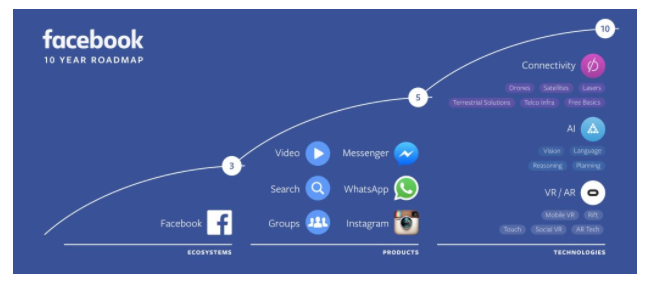
Now that the social giant has a loyal audience base locked in and a diverse range of products to engage these audiences, they’re leading the next stage of evolution in how we interact.
Ten years ago, it was mostly text. Individual updates. Remember how we would all compete to write the wittiest, most creative statements to fill in our status boxes? “Bob is…” fill in the blanks.
Five years ago, it became photos and group messaging.
And now, we are looking at the three dimensional. At quicker, easier, more interactive ways to communicate using a manipulation of space and using our minds.
This year’s updates are faster and more furious alright. David Pierce of Wired says, “Think of the keynote as a heatmap for Facebook, indicating what the company cares about.”
F8 2017 told us that Facebook has big ambitions and even bigger technologies that will impact us beyond our personal social circles and beyond the consumer-marketer relationship. Virtual reality, augmented reality, and artificial intelligence – all things that sound straight out of a sci-fi film are now becoming very much tangible. And they will change the way we talk, learn, share, and buy in the coming years.
Digital & Social Articles on Business 2 Community
(55)

